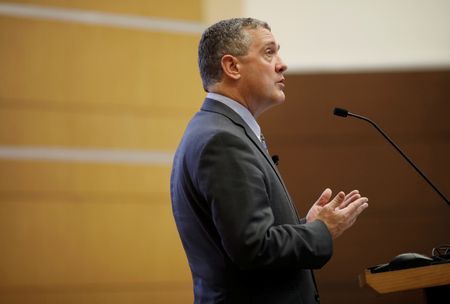
(Reuters) -Federal Reserve policymakers on Friday began to publicly sketch out their views of the outlook for interest rates and the U.S. economy, two days after the central bank rolled out its largest interest rate increase in more than a quarter of a century to stem a surge in inflation.
Both the Fed and the European Central Bank, which is also facing severe price pressures, have enough credibility to engineer a reduction in inflation without causing a deep recession, St. Louis Fed President James Bullard said on Friday.
“The Volcker disinflation was costly, but it was not credible initially – Volcker had to earn credibility,” Bullard said at the Barcelona School of Economics Summer Forum, referring to former Fed Chair Paul Volcker, who sent unemployment soaring 40 years ago with his sharp interest rate hikes. “The Fed and the ECB have considerable credibility, suggesting that a soft landing is feasible in the U.S. and the euro area if the post-pandemic regime shift is executed well.”
Bullard has been a vocal backer of the increasingly aggressive actions the Fed has taken since March, when it raised its benchmark overnight interest rate by a quarter of a percentage point, and followed with a half-percentage-point increase in May and a 0.75-percentage-point hike this week.
U.S. central bank forecasts published alongside the Fed’s policy decision on Wednesday show most policymakers see the federal funds rate rising to at least 3.4% this year. It is currently in a range of 1.50% to 1.75%.
Minneapolis Fed President Neel Kashkari, in an essay published on the regional bank’s website, said he supported this week’s rate hike and could support another similar-sized one in July, but said the Fed should be “cautious” about doing too much too fast.
“A prudent strategy might be, after the July meeting, to simply continue with 50-basis-point hikes until inflation is well on its way down to 2 percent,” Kashkari said. “Taking a steady approach to driving long real rates higher might help us avoid tightening more than is necessary to restore price stability, while ensuring that we do enough.”
Kansas City Fed President Esther George, who dissented on this week’s policy decision, said on Friday that she did so because she “viewed that move as adding to policy uncertainty simultaneous with the start of balance sheet runoff.”
Her objection to Wednesday’s policy action notwithstanding, George said she shares the rate-setting Federal Open Market Committee’s “strong commitment to bring down inflation to achieve our mandate for long-run price stability.”
Inflation, as measured by the Personal Consumption Expenditures Price Index, is running at more than three times the Fed’s 2% target.
(Reporting by Ann Saphir and Dan Burns; Editing by Paul Simao)

